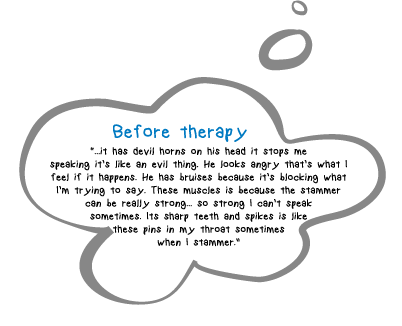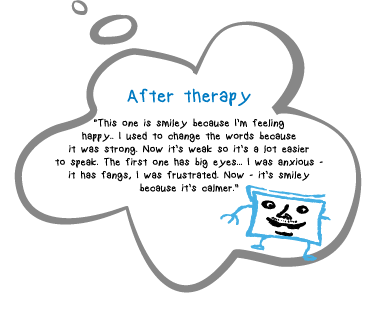Before Therapy

These pictures were drawn by a child when asked to ‘draw his stammer’, before and after receiving therapy. They help us understand what it can feel like to have a stammer and show how therapy can help.


Having a child who stammers in your class can be a challenging experience. Why is he stammering one moment and fine the next? Is he putting it on? What should I do about the register?
Children usually start to stammer between the ages of 2 and 5 years old, a time when their language skills are developing rapidly. Around 5% of children start to stammer and around four out of five will overcome it; some will just naturally grow out of it, and others will stop with early therapy. 1 % of children may continue to stammer into adulthood.
When someone stammers you might hear…
- Repetitions of whole, single-syllable words, e.g. “and and and”
- Repetitions of sounds, e.g. “b-because”
- Stretching out sounds (prolongations), e.g. “lllike”
- Words appearing to ‘get stuck’ (blocks), where the airflow stops and nothing comes out.
Children can become experts in ‘hiding’ their stammer. They might avoid talking completely in some situations, say less, or change words in order to appear more fluent. Within the classroom they might pretend they don’t know the answer, give very brief answers, not put their hand up, or not volunteer for tasks that involve speaking.
Stammering is different for everyone, and often what other people can see or hear when someone stammers is only the ‘tip of the iceberg’. Stammering can affect a child’s emotional wellbeing and their ability to communicate as they would like. In school, possible challenges include:
- Reading out loud or talking in front of the class or school;
- Answering the register;
- Taking part in fast moving conversations in the playground;
- Being distracted by worries about speech, making it hard to concentrate and learn;
- Being teased or bullied, and;
- Speaking under time pressure.
Our Stammering Information Programme project asked over 50 children/young people what they wanted teachers to know.
Top Tips
- We are more than just our stammer.
“I don’t think that the stammer is my main feature, I’m just a normal 18 year old.” - There is no link between stammering and intelligence.
“If the first thing you do is talk funny, people sometimes think that you’re not as bright.” - Certain situations make us stammer more.
“… it would make me feel more uncomfortable and then that would normally lead to me stammering more.”
How to help us
- Ask us how you can help.
“I would really like my teacher to come over to me and have a little talk.” - Give us time to think and speak.
“After I’ve been asked a question if I was given the time to start thinking about the answer and my speech as well it would be very helpful because I could think of some techniques for my speech.” - Tell us we’re doing ok – but don’t advise us about our speech.
“I don’t really like being told to slow down.”
“People tell me to hurry up, I speed up and then stammer more.”
Michael Palin Centre Helpline Available 9-5, Monday to Friday Call: 0203 316 8100 www.stammeringcentre.org
Please login to view this content
Login